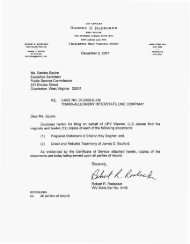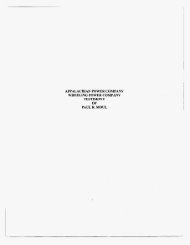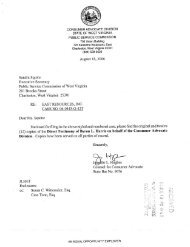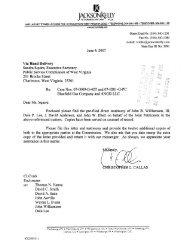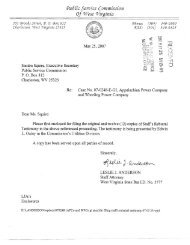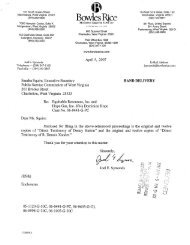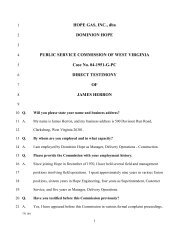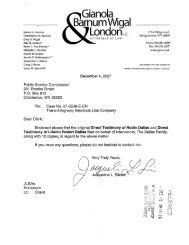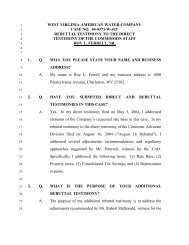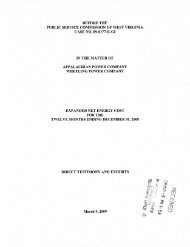Direct Testimony of Thomas M. Hildebrand - Consumer Advocate ...
Direct Testimony of Thomas M. Hildebrand - Consumer Advocate ...
Direct Testimony of Thomas M. Hildebrand - Consumer Advocate ...
Create successful ePaper yourself
Turn your PDF publications into a flip-book with our unique Google optimized e-Paper software.
I<br />
uyL. 4 VI J<br />
contain any nutrient pollution.<br />
Additionally, homeowners that aren't connected to water treatment networks are<br />
sources <strong>of</strong> nutrient pollution. Generally they rely on individual septic systems,<br />
many <strong>of</strong> which will fail and leak over their lifetime. These systems typically have<br />
had no, or very limited maintenance and some are several decades old.<br />
Currently private septic tanks are estimated at contributing 4% <strong>of</strong> the nutrient<br />
pollution found in the bay. An inspection program should be implemented, with<br />
graduated upgrades required, to ensure these systems aren't leaking and are<br />
adequately neutralizing their nutrient pollution.<br />
Finally, private lawn fertilization also contributes to water pollution. One way to<br />
raise clean-up funds while reducing water pollution could be a fertilizer tax. This<br />
tax could be levied against all fertilizers based on concentrations <strong>of</strong> nitrogen and<br />
phosphorus per pound equal to an estimated clean up cost, both for commercial<br />
farms and private homeowners. The proceeds <strong>of</strong> this tax could be used to further<br />
fund non-point source reductions and improve public awareness <strong>of</strong> the myriad <strong>of</strong><br />
factors that have changed the bay from one <strong>of</strong> the most productive ecosystems<br />
in America to an estuary that is struggling to survive.<br />
Saving the Bay will require a concerted effort on behalf <strong>of</strong> policymakers,<br />
industries, farmers, and citizens across the watershed, but the return on this<br />
investment will be substantial. The Clean Air Act has reportedly returned 4 times<br />
its implementation cost, and the bay could see such high returns as well. These<br />
returns will come from increased, sustainable harvests <strong>of</strong> fish and shellfish as the<br />
bay's populations recover, increased tourism to rehabilitated areas, and the<br />
inherent value <strong>of</strong> an ecosystem in balance. While these returns show great<br />
potential, we must be willing to make a real investment now for the future health<br />
<strong>of</strong> the Bay.<br />
Mr. Logan is a first year law student at the University <strong>of</strong> Virginia. Mr. Litten is a<br />
Harrisonburg attorney.<br />
y i i ? bsmess Oril ne j Conta:: IJS 'debmaster<br />
Vtrg!niaBus!ness.com is part <strong>of</strong> the Catewayda network<br />
@ 2007, M&a General Operations lrc , publisher <strong>of</strong> Virginia Business<br />
Use <strong>of</strong> this websire IS subject to certain ter-s and cowttioiis



